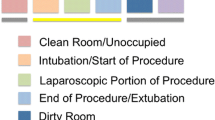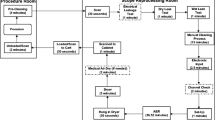Abstract
Massachusetts General Hospital (MGH) manages a large inventory of surgical equipment which must be delivered to operating rooms on-time, efficiently, and according to a set of quality standards and regulatory guidelines. In recent years, flexible scope management has become a topic of interest for many hospitals, as they face pressure to reduce costs, prevent infections that can result from mismanagement, and are under increased regulatory oversight. This work conducted at MGH proposes a novel method for surgical equipment management in a hospital. The proposed solution uses a real-time locating system to track flexible scopes, a semantic reasoning engine to determine the state of each scope, and a user interface to inform staff about necessary interventions to avoid scope expirations while maximizing efficiency. This study aimed to accomplish three primary goals. First, the study sought to improve the hospital’s compliance to quality standards in order to reduce risks of infection due to expired scopes. Second, the study aimed to improve the cost-efficiency of scope disinfecting processes through more efficient inventory management. Finally, the study served as an opportunity for the hospital to establish best practices for working with the newly installed real-time locating system. The system proposed in this work was implemented at MGH on a subset of the hospital’s flexible scopes. The study results demonstrated a quality compliance increase from 88.9% to 94.5%. The study also showed an estimated $17,350 annual cost savings due to more efficient scope management. Finally, the study demonstrated the feasibility, increase in regulatory compliance, and cost savings that would make this technology valuable when scaled across the hospital to other types of scopes and medical devices.




Similar content being viewed by others
References
Centers for Disease Control & Prevention. A Rational Approach to Disinfection and Sterilization. https://www.cdc.gov/infectioncontrol/guidelines/disinfection/rational-approach.html. Published September 18, 2016. Accessed March 5, 2019.
Schmelzer, M., Daniels, G., and Hough, H., Safe storage time for reprocessed flexible endoscopes: A systematic review. JBI Database Syst. Rev. Implement. Reports. 12(9):187, 2015.
Petersen, B. T., Chennat, J., Cohen, J. et al., Multisociety guideline on reprocessing flexible GI endoscopes: 2011. Source Infect. Control Hosp. Epidemiol. 32(6):527–537, 2011.
Ofstead, L. C., Quick, M. R., Eiland, J. E., and Adams, S. J., A glimpse at the true cost of reprocessing endoscopes. Communiqué. 2017:63–78, 2017.
Roberts, C. M., Radio frequency identification (RFID). Comput. Secur. 25(1):18–26, 2006.
Hellmich, T. R., Clements, C. M., El-Sherif, N. et al., Contact tracing with a real-time location system: A case study of increasing relative effectiveness in an emergency department. Am. J. Infect. Control. 45(12):1308–1311, 2017.
Arunachalam SP, Sir M, Marisamy G, et al. Optimizing emergency department workflow using radio frequency identification device (RFID) data analytics. Des. Med. Devices Conf. April 2017: V001T12A002, 2017
Arunachalam, S.P., Sir, M., Marisamy, G., et al. Identifying factors influencing patient alone time at the emergency department using RFID data: What is next?. 2017 IEEE EMBS Int. Conf. Biomed. Heal. Informatics. 2017: 225–228.
Pasupathy, K., Heaton, H., Nestler, D. et al., Characterization of Emergency Department Abandonment Using Real-Time Location System. Ann. Emerg. Med 70(4):54, 2017.
Karalius, V. P., Nestler, D. M., Koenig, K. R. et al., Measuring radio-frequency identification sensitivity and precision in the emergency department: A method for clinically relevant assessment of real-time location services. J. Periodontol. 70(48):306–313, 2017.
Versus. Dana-Dana-Farber: Transforming Process Improvement with RTLS. http://www.versustech.com/rtls-news/blog/dana-farber-himss15-presentation-transforming-process-improvement-through-rtls-data/. Published April 30, 2015. Accessed February 23, 2019.
Midmark. The Johns Hopkins Hospital: Enterprise Case Study. https://www.midmark.com/docs/default-source/documents/midmark_rtls_the_johns_hopkins_hospital_case_study.pdf. Published 2019. Accessed March 5, 2019.
CenTrak. CenTrak’s Medical Scope Management System - CenTrak | Enterprise Location Services. https://www.centrak.com/press-releases/centraks-medical-scope-management-system/. Published April 7, 2015. Accessed March 5, 2019.
Belgueliel, Y., Bourahla, M., and Brik, M., Towards an ontology for UML state machines. Lect. Notes Softw. Eng. 2(1):116–120, 2014.
Acknowledgements
The authors would like to thank Retsef Levi, Karen Taborda-Marin, Meaghan Gray, Mark Rosa, Juliana Angel Citrone, Milcho Nikolov, Cecilia Zenteno, and Martin Copenhaver for their assistance throughout this project.
Author information
Authors and Affiliations
Corresponding author
Ethics declarations
Conflict of Interest
Jason C. Troutner declares that he has no conflicts of interest. Matthew V. Harrell declares that he has no conflicts of interest. Mark T. Seelen declares that he has no conflicts of interest. Bethany J. Daily declares that she has no conflicts of interest. Wilton C. Levine declares that he has no conflicts of interest.
Ethical Approval
This article does not contain any studies with human participants or animals performed by any of the authors.
Additional information
Publisher’s Note
Springer Nature remains neutral with regard to jurisdictional claims in published maps and institutional affiliations.
This article is part of the Topical Collection on Systems-Level Quality Improvement
Rights and permissions
About this article
Cite this article
Troutner, J.C., Harrell, M.V., Seelen, M.T. et al. Using Real-Time Locating Systems to Optimize Endoscope Use at a Large Academic Medical Center. J Med Syst 44, 71 (2020). https://doi.org/10.1007/s10916-020-1540-x
Received:
Accepted:
Published:
DOI: https://doi.org/10.1007/s10916-020-1540-x




